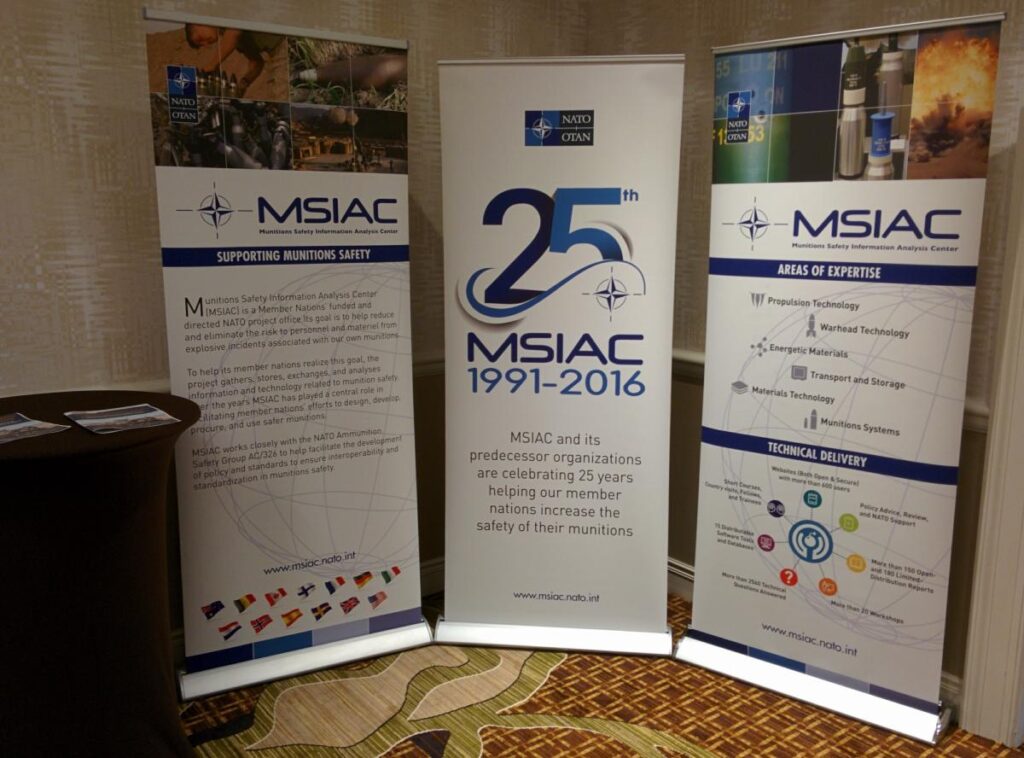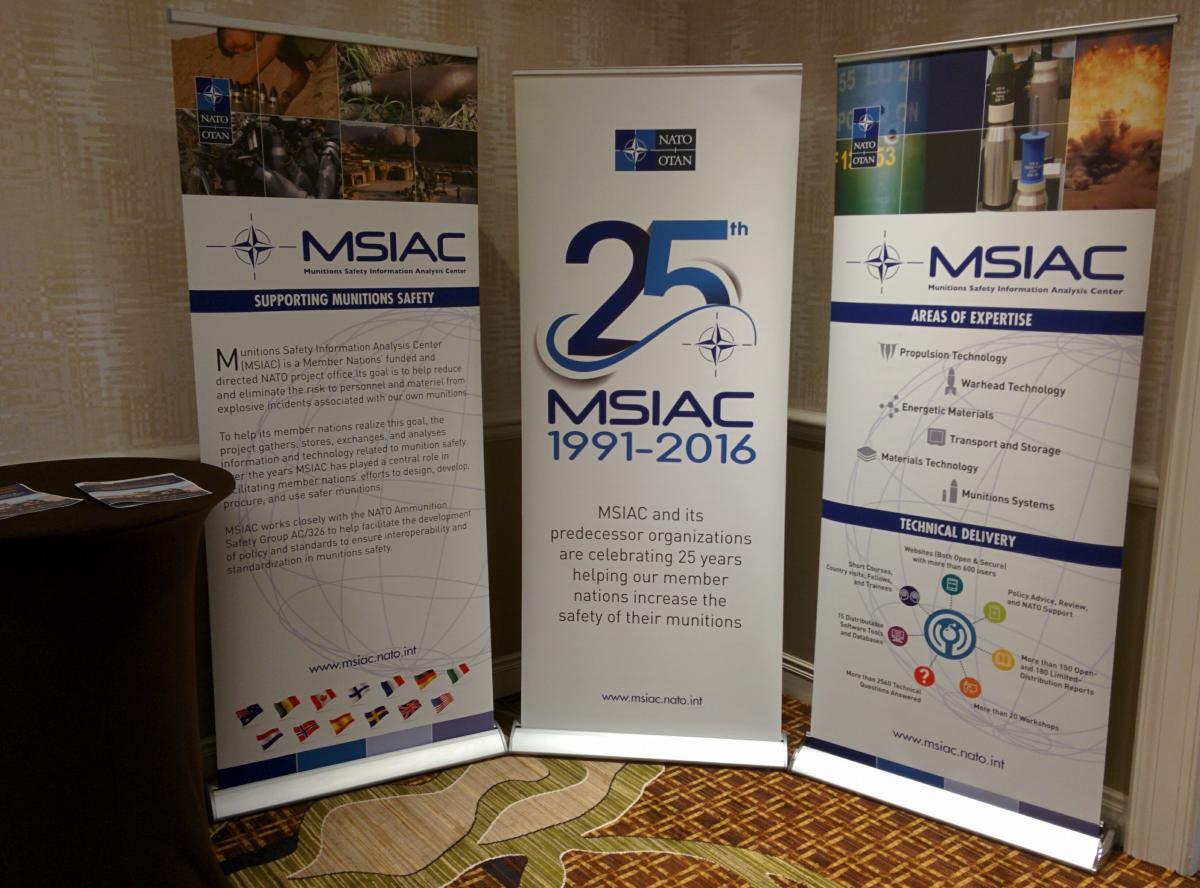2016 Insensitive Munitions & Energetic Materials Technology Symposium Review

This year the Insensitive Munitions & Energetic Materials Technology Symposium (IMEMTS) was held in Nashville, Tennessee at the vast Gaylord Opryland Hotel. The topic of the three-day symposium was “Advanced IM/EM Solutions: Minimizing Risk to our Warfighters and Delivering Needed Performance, Security, and Readiness to Address Evolving Threats in our World.” More than 250 people were registered for the symposium, representing 21 nations. In total 86 presentations were delivered and 21 posters were available for attendees.

MSIAC was represented by four TSO’s (Warhead, Propulsion, Energetic Materials and Material Technology) and the Project Manager. MSIAC personnel chaired three sessions, delivered four session papers, one plenary paper and one keynote address and were also involved in a total of seven papers. When not presenting papers, the MSIAC staff could be found by the MSIAC booth providing information, flyers and pens to the attendees.
The keynote address was given by Dr. Baker, covering his lifetime of energetics experiences. He is the MSIAC Warheads TSO since June 2016 and is recently retired from the US Army ARDEC. He discussed his youthful energetic experiences including fun with chemistry, reloading powder, and explosives avalanche control; his benefiting from broad technical community interaction including the US Army, US DoD, US DOE, industry, academia and international; and outlined the differences in national energetics policies and approaches observed while at MSIAC. The presentation ended with a recounting of his worst day (death of colleagues) and best day (lives saved due to insensitive munitions). He stressed the importance of the work done by the international safety and insensitive munitions community, as well as the required maintenance of technical excellence.
The plenary session provided a good introduction to the symposium by covering a number of IM and EM topics. Mr. Di Stasio (ARDEC) covered the progress that the US Joint Insensitive Munitions Technology Program (JIMTP) has made on promoting development and delivery of solutions to a range of munitions. This work includes the promotion of new materials through the “Molecule of the Year”, new technologies that has seen a 300 % increase in funding, and updating the program requirements to include performance as well as IM goals.
Dr. Sharp (MSIAC) reflected on the past 25 years of how both NATO Insensitive Munitions Information Center (NIMIC) and MSIAC had evolved and were actively engaged with the development of munitions safety. For further information see the 25th anniversary article in this newsletter.
This was followed by Dr. Price (BAe Systems) who provided an overview of the Green Insensitive Munitions Explosive (GrIMEx) program. The aim of the program was to develop novel IM replacements for RDX and TNT to formulate a greener “Composition B.” It has been a multi-year collaborative effort with the Strategic Environmental Research and Development Program (SERDP) and United States Army Public Health Command (USAPHC). Progression of the work has shown that, with respect to toxicity, 2-bromo-4-methoxy-1,3,5-trinitrobenzene (TNBA) and 3,4-dinitropyrazole (DNP) are both viable TNT replacements and that 2,6-diamino-3,5-dinitropyrazine-1-oxide (LLM-105), 2,6-dinitro-2,4,6,8-tetraazabicyclo[3.3.0]octan-3,7-dione (DNGU) and fluid energy milled 1,3,5,7-tetranitro-1,3,5,7-tetraazacyclooctane (FEM-HMX) can be used as a replacement for RDX.
Lastly Mr. Guengant (Airbus) provided the European industry’s Insensitive Munitions and Explosive Materials Group (IMEMG) perspective on potential improvements to IM-related STANAGs and AOPs. The review focused on AOP-39 analysis by the Hazard Assessment & Classification Expert Working Group of IMEMG.
MSIAC Awards
This year’s career achievement awards were given to Mr. Bruno Nougez (France, not present) and Mr. Steve Struck (US Air Force). The IM Team Achievement award was given to the Brimstone 2 Project which consisted of a multinational team from Roxel UK, MBDA UK, TDW Gmbh DEU and UK MoD. A Steering Committee recognition award was given to Mr. Ronald Derr (US) for his outstanding contribution and support to NIMIC & MSIAC. For further details see the PM’s Perspective.
Highlights
The following section contains only material, process & system highlights from the symposium.
Energetic Materials
Continued work and scale up on 3,4-dinitropyrazole (DNP) was presented by three authors: Dr. Price (BAe), Dr. Morris (BAe) and Dr. Ritums (FOI). This melt cast explosive has good performance properties (c.f. TNT) and an accessible melting temperature (88°C) for processing using steam and current melt cast facilities. Improvements to the synthetic route and scale up have been carried out by BAe Holston at the pilot plant scale. Some reported issues with DNP include long cooling times and low viscosity of the molten-phase leading to potential sedimentation with solid fills. According to Ritums, DNP is more shock-sensitive (using French Mini Gap Test) than TNT.
A one-pot synthesis (Samuels, ARDEC) and pilot plant scale up (Velarde, Orbital-ATK) for DEMN, a eutectic salt comprising of Diethylenetriamine trinitrate, Ethylenediamine dinitrate, Methyl nitroguanidine and Nitroguanidine, was discussed. The material, as a melt cast, has an achievable melting temperature, good compatibility with potential solid energetic fills, low vapour pressure and reasonable performance.
Dinitromelamine (DNAM) was presented by Mr. Samuels (ARDEC) as a potential RDX booster replacement. Despite being hydrolysable formulations were made using inert, non-aqueous processing liquids during granulation.
Processing
Fluid Energy Milled (FEM) HMX was discussed a number of times during the symposium and work by Mr. Alexander (BAe) replaced part of the HMX fill with FEM-HMX to reduce the shock sensitivity of LX-14. The program of work highlighted which particle size fraction of HMX required replacing to achieve a less-sensitive formulation.
Formulations
Mr. Johanson (Chemring) presented a series of melt cast formulations based on DNAN and TNT matrices that contained NTO, RDX and/or HMX. MCX-6002 (NTO/TNT/RDX) performed like Composition B but was less shock sensitive and had a larger critical diameter; reaction to fast and slow cook off was not presented for this formulation. MCX-6100 (NTO/DNAN/RDX), similar in composition to IMX-104, performed well across the qualification trials and was similar to IMX-104 data. The FCO & SCO Tube Test results were good with low reaction levels reported for both tests.
A new booster formulation based on HMX, LLM-105 and Viton (ARLX-4201) was presented by Dr. Piehler (ARL). The formulation was designed to replace PBXW-14; TATB/HMX/Viton formulation. The reported IHE Gap Test results showed that ARLX-4201 was less sensitive than PBXW-14, and that the response to the VCCT was less violent at high confinement.
Propellants
Nitroisobutanetrinitrate (NIBTN), a potential NG replacement plasticizer (Paraskos) was designated the molecule of the year by JIMTP.
An overview of ARDEC activities was provided by Mr. Caravaca (ARDEC). This covers areas like 3-D printing of gun propellant, novel ingredients, sub-scale SCO screening tools, venting technologies for cartridge case, co-extrusion and new ignition systems.
BAE systems (Dr. Penny) presented LOVA formulations using thermoplastic elastomer (TPE) for high energy 120 mm tank application as well as lower energy for artillery application.
Green stabilisers were presented by Eurenco PB Clermont (Dr. Dobson) to replace conventional stabiliser.
The Nammo GAP propellant was presented as the first GAP propellant formulation qualified by the UK MOD, for use in the LMM missile. It is based on GAP, RS-RDX and Bu-NENA.
Research on parameters influencing the shock reaction mechanisms of rocket motor (e.g. SDT, XDT) was presented by both the US and the UK.
Testing
AOP-39 projection criteria was the subject of two papers of particular interest related to IM testing. Mr. Pudlak (ARDEC) discussed IM Type IV lethal fragment projection energy threshold calculations and potential paths forward for updated IM assessment criteria. Dr. Baker (MSIAC) presented similar work done by Mr. van der Voort (MSIAC) on projection criteria for IM and Hazard Classification. Both presentations showed that the current 20J mass-distance relationships are based on launch energy rather than impact energy as commonly believed.
Among a number of presentations on alternative heating methods for fast and slow cook off testing and examining the dynamics within the fast cook off heating environment, Dr. Washburn (NSWC-CL) provided particular insights on calibrating a propane-fuelled burner used for fast cook-off testing. This correlates nicely with an on-going update to NATO STANAG 4240 for fast heating test procedures. Dr. Washburn’s presentation provided quantitative data supporting such an update, as well as methodology for testing calibration. There were a number of other interesting presentations within this same topic area, including a radiative panel alternative heating method (Moriceau, Herakles), examination of the environmental impact of the fuel fire (Hubble, Dahlgren), and the blockage effects from packaging items within the fire (Yagla, Dahlgren).
A presentation on the MSIAC audit procedure missile testing was provided by Mr. Pechoux (DGA) from the French MoD/DGA Test Centre. This comprehensive presentation detailed the methodology and application of the testing audit procedure to the DGA missile testing and capabilities. This procedure helps to verify and validate that the testing is complete, detailed and uniform in order to provide for assured comprehensive results that are comparable between different test centres.


